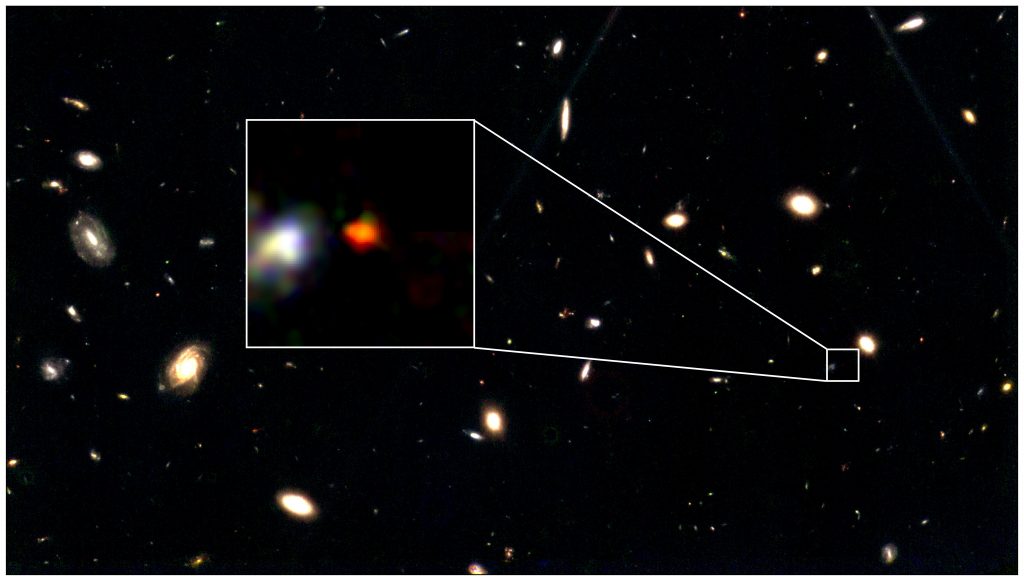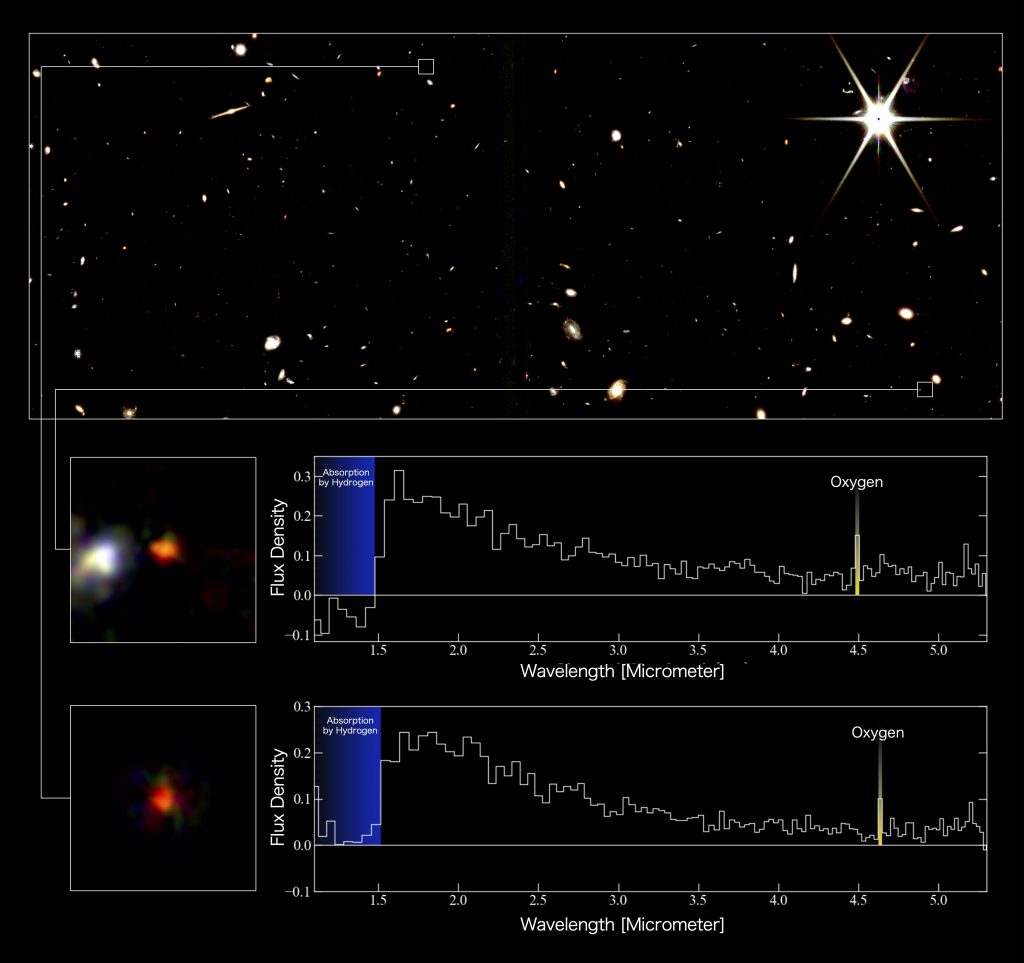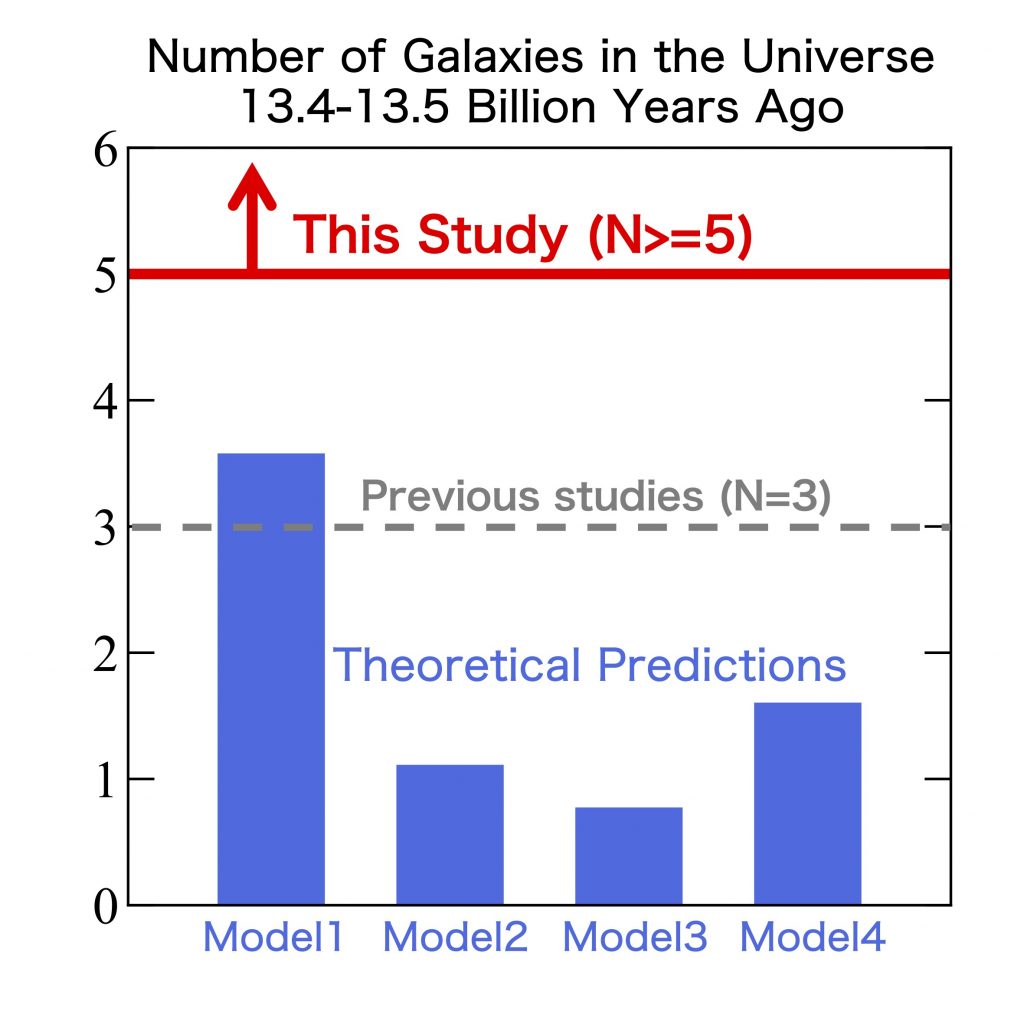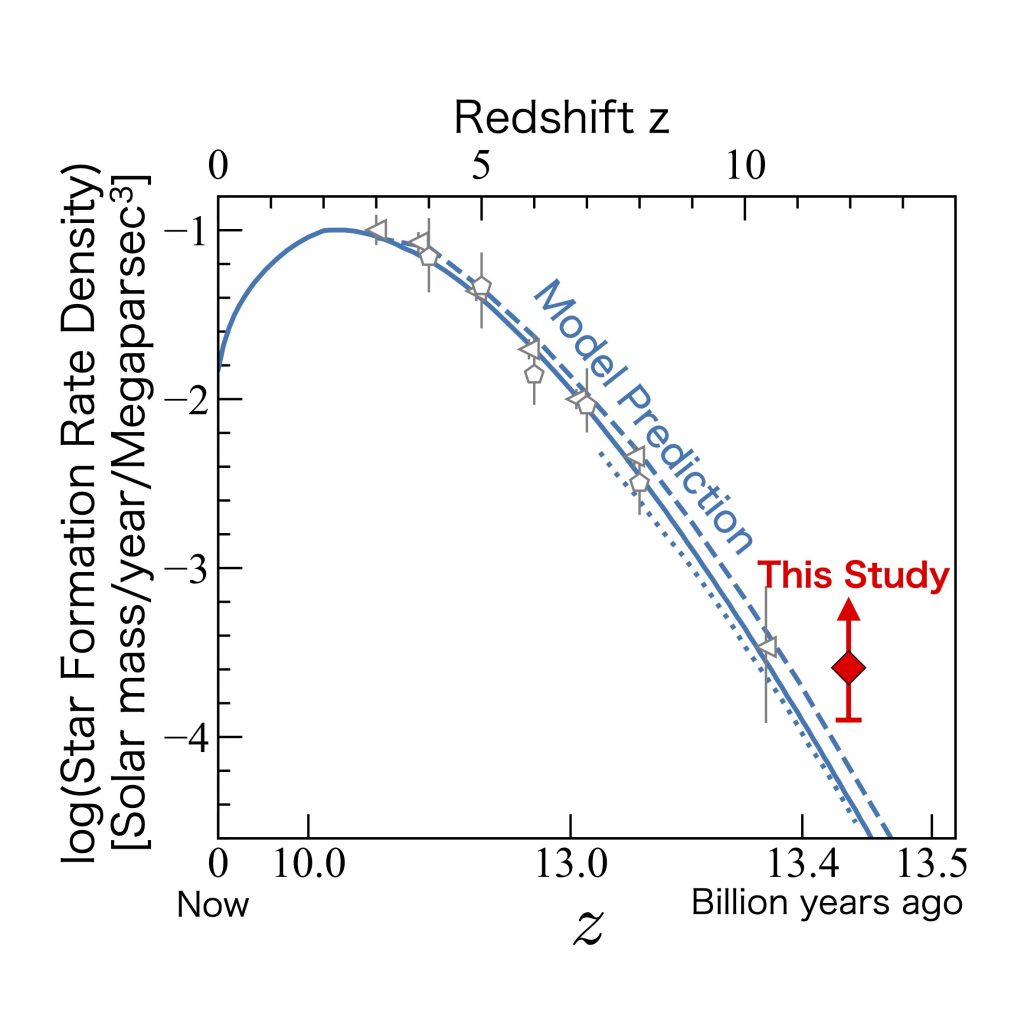James Webb Space Telescope Discovery
Clicking on each image will open the full resolution one. Try it!Clicking on "Raw images" image will yield all the relevant raw images.
The Cosmic Dawn was Brighter Than Expected
A research team successfully measured the precise distance of two bright galaxies located 13.4 billion light-years away in the universe, using spectroscopic observation data from JWST (Fig 1). In the most distant universe spanning 13.4 to 13.5 billion light-years, only three galaxies had been confirmed previously, leaving uncertainty regarding whether these findings contradicted theoretical predictions or not. With this confirmation of two additional galaxies by the team, now the number of confirmed galaxies has surpassed any prior theoretical predictions made before the launch of JWST, indicating an active star formation within a short period in the early universe. This result presents the possibility that a formation process for early galaxies, including the primordial ones, differs from previously believed theories for galaxy formation.
The universe was born around 13.8 billion years ago with the Big Bang, and the subsequent formation of the first stars and the first galaxies occurred a few hundred million years later. This era is known as the “cosmic dawn.” Despite extensive exploration using large telescopes such as Subaru and Hubble, only a handful of galaxies existing in the early universe, prior to 13.4 billion years ago, have been found, and their precise distances remained unclear. This challenge stems from the fact that the wavelength of the light emitted by galaxies from over 13.4 billion years ago has stretched due to the universe’s expansion, shifting into the infrared spectrum, where previous large telescopes cannot conduct sensitive observations.
JWST achieves sensitivity in the infrared wavelength 10 to 1000 times higher than other telescopes, enabling the discovery of numerous candidate galaxies from as far back as 13.4 to 13.6 billion years ago.
The team analyzed spectroscopic observational data obtained through JWST. They successfully detected an oxygen emission line and hydrogen absorption with high precision (at a significance of over 99.9999%) from two candidates for galaxies dating back 13.4 billion years (Fig 2), determining their precise distances as 13.40 and 13.42 billion light-years, respectively. Harikane: “Thanks to the high sensitivity of JWST’s observations, we detected not only hydrogen absorption commonly observed in early galaxies but also the oxygen emission line with remarkable accuracy from galaxies dating back 13.4 billion years, successfully measuring the precise distances to these galaxies.” Kimihiko Nakajima explains the significance of this study: “Previous studies of the most distant galaxies were mostly based on candidates found from images, but there was always concern about the uncertainty in determining the distance to these galaxies. This research, based on spectroscopic observations providing accurate distances, allows for discussions with higher reliability compared to previous studies, presenting immensely significant scientific value.”
In the most distant universe, 13.4 to 13.5 billion light-years away, three galaxies had previously been confirmed through spectroscopic observations, with uncertainty prevailing regarding whether these findings contradicted theoretical predictions. With the addition of two new galaxies confirmed by the teram, a total of five galaxies have now been identified in the early universe, dating back approximately 300 to 400 million years after the Big Bang. Harikane states, “Before the launch of JWST, large telescopes were used to study distant galaxies and their results were well explained by various theoretical models. However, the discovery of these five galaxies in the most distant universe by JWST was unexpected in any of those theoretical models!”
Additionally, the research team investigated the rate of star formation based on the brightness of galaxies. They found that in the universe 13.4 to 13.5 billion years ago, the rate of star formation is over four times higher than predicted by models, implying that stars are being born at a much faster pace than anticipated (Fig 4). This result suggests a possibility that the process of galaxy formation in the early universe, including the first galaxies, might differ from previously believed theories. Masami Ouchi explains, “These observational findings indicate the existence of some mechanism in the early universe that actively triggers the birth of stars, challenging the long-held theories of star and galaxy formation that we have maintained for years. Alternatively, these five galaxies might shine brightly due not to stars but due to the activity of supermassive black holes. In that scenario, it would imply the existence of supermassive black holes in the early universe, posing significant questions about their birth and growth.”
Through this study, it has become clear that in the most universe, stars are forming more vigorously than predicted by theoretical models, illuminating the era of the cosmic dawn. It is possible that even the first galaxies also hosted active star formation. Besides this finding, JWST has also succeeded in detecting an rapid increase of oxygen, nitrogen-rich galaxies, and the discovery of numerous supermassive black holes in the early universe.
Credit: The University of Tokyo, Harikane et al.
 Fig 1: CEERS2_588
Fig 1: CEERS2_588
 Fig 2: Two galaxies from 13.4 billion light-years away (upper panel) and their spectra (lower panel).
Fig 2: Two galaxies from 13.4 billion light-years away (upper panel) and their spectra (lower panel).
 Fig 3: Number of galaxies from 13.4 to 13.5 billion years ago. The blue histogram represents the expected number of galaxies predicted by theoretical models published before the launch of JWST. The actual number of galaxies with accurately measured distances (5 galaxies; in red) surpasses these theoretical predictions. As there could be additional candidate galaxies in this era, the real count might further increase, indicated by the upward-pointing arrow.
Fig 3: Number of galaxies from 13.4 to 13.5 billion years ago. The blue histogram represents the expected number of galaxies predicted by theoretical models published before the launch of JWST. The actual number of galaxies with accurately measured distances (5 galaxies; in red) surpasses these theoretical predictions. As there could be additional candidate galaxies in this era, the real count might further increase, indicated by the upward-pointing arrow.
 Fig 4: Star formation rate density across various epochs in the universe. The blue line represents predictions from multiple models, reproducing the observation results (in grey) until 13.3 billion years ago (redshift z=10). The annual birth rate of stars calculated from galaxies 13.4 to 13.5 billion years ago (in red) is over four times higher than the predictions of several models, indicating a rapid and successive birth of stars within a shorter period. The vertical axis represents the average star formation rate density across the entire universe, measured in units of solar mass per volume (cubic megaparsecs) per year. The horizontal axis represents the universe’s age with reference to the present or the redshift.
Fig 4: Star formation rate density across various epochs in the universe. The blue line represents predictions from multiple models, reproducing the observation results (in grey) until 13.3 billion years ago (redshift z=10). The annual birth rate of stars calculated from galaxies 13.4 to 13.5 billion years ago (in red) is over four times higher than the predictions of several models, indicating a rapid and successive birth of stars within a shorter period. The vertical axis represents the average star formation rate density across the entire universe, measured in units of solar mass per volume (cubic megaparsecs) per year. The horizontal axis represents the universe’s age with reference to the present or the redshift.